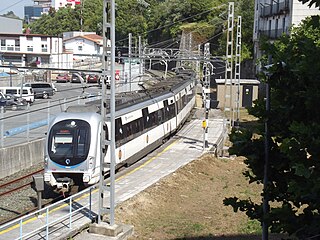
Euskotren Trena, formerly known just as Euskotren is a commuter, inter-city and urban transit train-operating company that operates local and inter-city passenger services in the provinces of Biscay and Gipuzkoa, in the Basque Country, Spain. It is one of the four commercial brands under which Euskotren operates, as a public company managed by the Basque government. The entire 181.1-kilometre (112.5 mi) network uses 1,000 mm narrow gauge rail tracks which have been owned by the Basque Government since their transferral from the Spanish government; the rail tracks and stations were part of the FEVE network until its transferral. Euskotren Trena also operates the Donostia/San Sebastián metro under the brand Metro Donostialdea.

Garai is an elizate, town and municipality located in the province of Biscay, in the Basque Country, Spain. Garai is part of the comarca of Durangaldea and has a population of 318 inhabitants as of 2009 according to the Spanish National Statistics Institute.

Eibar is a city and municipality within the province of Gipuzkoa, in the Basque Country of Spain. It is the capital of the eskualde / comarca of Debabarrena.
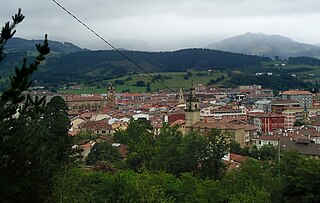
Durango is a town and municipality of the historical territory and province of Biscay, located in the Basque Country, Spain. It is the main town of Durangaldea, one of the comarcas of Biscay. Because of its economical activities and population, Durango is considered one of the largest towns in Biscay after the ones that compose the conurbation of Greater Bilbao.

Ajangiz is a town and municipality in the province of Biscay, in the Basque Country. It is located in the Busturialdea comarca, and was part of the municipality of Gernika-Lumo between 1940 and 1991.

Arrieta is a town and municipality located in the province of Biscay, in the Basque Country, Spain. Arrieta is part of the comarca of Mungialdea. It had a population of 552 inhabitants as of 2007, and a population of 564 inhabitants as of 2017.

Atxondo is a municipality located in the province of Biscay, in the Basque Country, Spain. Atxondo is part of the comarca of Durangaldea and has a population of 1,447 inhabitants as of 2007 according to the Spanish National Statistics Institute.

Berriz is an elizate, town and municipality located in the province of Biscay, in the Basque Country, northern Spain. Berriz is part of the comarca of Durangaldea and has a population of 4.623 inhabitants as of 2019 and according to the Spanish National Statistics Institute.

Elorrio is a town and a municipality located in the eastern part of the province of Biscay, in the Basque Country, in northern Spain. As of 2017, it has a population of 7,307 inhabitants. It covers an area of 37.20 square kilometers and it has a population density of 193.58 people per square kilometer. It holds the medieval title of Most Loyal and Noble Villa.

Ermua is a town and municipality located in the province of Biscay, in the autonomous community of Basque Country, northern Spain. In 2019, Ermua had 15,880 inhabitants.
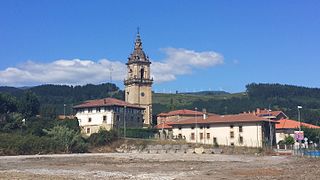
Iurreta is a town and municipality located in the province of Biscay, in the autonomous community of Basque Autonomous Community, northern Spain. Incorporated into the municipality of Durango in 1926, Iurreta regained its independent status in 1990. The traditional anteiglesia or town meeting system of local government was revived.

Izurtza is an elizate, town and municipality located in the province of Biscay, in the Basque Country, Spain. Izurtza is part of the comarca of Durangaldea and has a population of 270 inhabitants as of 2010 and according to the Spanish National Statistics Institute.

Mañaria is an elizate, town and municipality located in the province of Biscay, in the Basque Country, Spain. Mañaria is part of the comarca of Durangaldea and has a population of 459 inhabitants as of 2006 according to the Spanish National Statistics Institute.
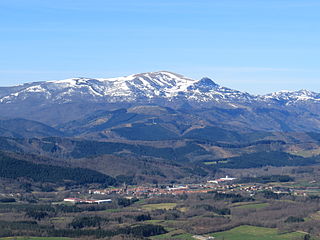
Otxandio is a town and municipality located in the province of Biscay, in the Basque autonomous community, Spain. Otxandio is part of the comarca of Durangaldea and has a population of 1,269 inhabitants as of 2010 according to the Spanish National Statistics Institute.
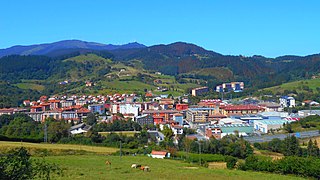
Zaldibar is an elizate, town and municipality located in the province of Biscay, in the Basque Country, Spain. Zaldibar is part of the comarca of Durangaldea and has a population of 3,043 inhabitants as of 2019 and according to the Spanish National Statistics Institute.
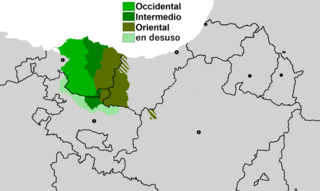
Biscayan, sometimes Bizkaian, is a dialect of the Basque language spoken mainly in Biscay, one of the provinces of the Basque Country of Spain.

Durangaldea is a comarca of Biscay located in the Basque Country, Spain. It is one of the seven eskualdeak/comarcas or regions that compose the province of Biscay. The capital city of Durangaldea is Durango.

The Lordship of Biscay was a region under feudal rule in the region of Biscay in the Iberian Peninsula between c.1040 and 1876, ruled by a political figure known as the Lord of Biscay. One of the Basque señoríos, it was a territory with its own political organization, with its own naval ensign, consulate in Bruges and customs offices in Balmaseda and Urduña, from the 11th century until 1876, when the Juntas Generales were abolished. Since 1379, when John I of Castile became the Lord of Biscay, the lordship was integrated into the Crown of Castile, and eventually the Kingdom of Spain.

Debabarrena is an eskualdea / comarca located in Gipuzkoa, Basque Country (Spain). It has an area of 180,3 km2. It is north from the comarca of Debagoiena, east from the province of Biscay, and south from the Gulf of Biscay.

The County of Durango, also known as Land of Durango and Merindad of Durango, was the ancient political administration of the territory that is now known as Durangaldea, in the Basque region of Biscay. This political administration included all the towns and elizates that existed within its territory. The elizates were all governed by the Foral law, while the towns had their own law. The county of Durango was a vassal state of the Kingdom of Pamplona, and in the 13th century it became a constituent part of the Lordship of Biscay. It has been part of the territory of Biscay since then. Its capital city was the town of Durango.
























